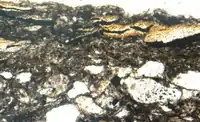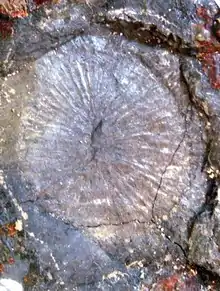Rutgersella
Rutgersella truexi is a form species for problematic fossils of Early Silurian age in Pennsylvania. It has been of special interest because of its morphological similarity with the iconic Ediacaran fossil Dickinsonia, and may have been a late surviving vendobiont.[1]

Petrographic thin section of Rutgersella truexi from Early Silurian Shawangunk Formation of Pennsylvania
| Rutgersella | |
|---|---|
 | |
| Rutgersella truexi from the Early Silurian Shawangunk Formation of Delaware Water Gap, Pennsylvania | |
| Scientific classification | |
| Kingdom: | |
| Genus: | †Rutgersella Johnson and Fox 1968 |
| Species | |
| |
Description
Rutgersella truexi is a flat, segmented fossil, with both radial and bilateral symmetry like Dickinsonia, but with a shorter midline. The fossils are pyritized; some internal chambers are filled with chalcedony, so that they are preserved along with basal rhizines. According to Retallack, these observations suggest affinities with lichens, and perhaps the fungal phylum Glomeromycota.[1]
References
- Retallack, G.J. (2015). "Reassessment of the problematic fossil Rutgersella as another post-Ediacaran vendobiont". Alcheringa. 39 (4): 573–588. doi:10.1080/03115518.2015.1069483.
This article is issued from Wikipedia. The text is licensed under Creative Commons - Attribution - Sharealike. Additional terms may apply for the media files.